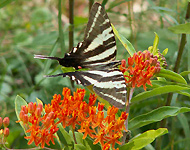
Marci Damon
Eco-friendly landscaping isn't just great for your local waterways and the Bay, it attracts local wildlife, as well. Resident and migratory birds, insects (including butterflies and bees), amphibians, reptiles, and mammals all benefit from a diversity of trees, grasses, and shrubs. And your local ecosystem will benefit from a diversity of wildlife. You can help support native wildlife with the following tips.
Planning A Yard That Welcomes Wildlife
- Choose native plants when restoring forests, wetlands, meadows, and shoreline buffers or creating formal landscape beds in a city or suburban garden. Most wildlife is dependent on native plants for food and cover.
- Plant a variety of native vegetation and choose plants with different heights at maturity. For example, tall oaks at the back of your property can be underplanted with smaller trees, (such as redbud), shrubs (such as high bush blueberry) and a groundcover (white wood asters). This type of "edge habitat" is actually preferred by many kinds of wildlife, since it provides food and cover at various levels.
- Do not deadhead flowers or seed heads; they are important nectar and food sources.
- Provide the necessary food, water, and cover components for wildlife.
Food Plants for Wildlife
- Nut and acorn trees (oaks, hickories)
- Plants for all seasons (spring and summer flowers, late blooming fall asters and goldenrods, and winter plants that retain their seeds).
- Hummingbird plants (native honeysuckle, trumpet creeper)
- Plants for butterflies and other pollinators
- Grasses and legumes
- Conifers
- Dead trees or snags
- Hedgerows
Water Sources
- Natural puddles that don't drain or drain slowly
- Streams, creeks
- Bird baths
- Man-made ponds
*Note that products are available for standing-water areas like puddles and bird baths that control mosquito larvae without endangering wildlife.
Cover for Resting and Nesting
- Brush and rock piles
- Dead trees or snags
- A mix of cover at all canopy levels: trees, shrubs, and groundcovers
- A no-mow meadow
- Bird nest boxes
- Hedgerows
- Evergreens (pines, holly)
Plant a Butterfly or Pollinator Garden
- Choose a sunny, sheltered location with average soil for a butterfly garden. The garden will feed butterflies but also other important pollinators, such as moths, wasps, bees, and beetles.
- Plant a mix of host plants (where eggs are laid and that caterpillars feed on) and nectar plants (that adult butterflies and moths feed on).
- Choose single flowered plants, not doubles that are hard for pollinators to access.
- Do not use pesticides or BT (Bacillus thurigiensis, used for controlling Japanese beetle grubs) on plants or your lawn; these are toxic to insects, including butterflies and caterpillars.
Wildlife Habitat Resources
National Wildlife Federation, Backyard Habitat Certification Program
Maryland Department of Natural Resources, Wild Acres Program
Pennsylvania Department of Conservation & Natural Resources, Landscaping with Native Plants
WindStar Wildlife Institute has a certification and internet course with emphasis on creating habitat for wildlife with native plants.


